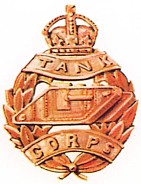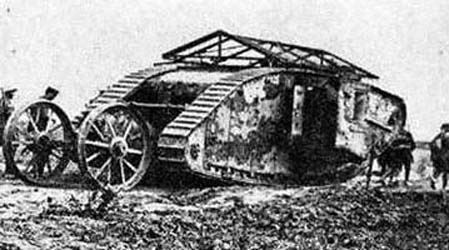British Tank Corps
La Grande-Bretagne fut la première nation au monde à concevoir et utiliser au combat des véhicules blindés chenillés, en 1916. Ce pays comme d'autres connaissait et utilisait les voitures blindées mais ces véhicules étaient bien trop délicats et fragiles pour opérer sur les terrain dévastés (criblé de cratères et de fils barbelés) du no man's land. Nous ne parlerons pas ici de la conception des premiers modèles de chars britanniques (voir les dossiers dans la partie "Vehicles") mais de la mise en place du Tank Corps britannique.
Great Britain was the first nation in the world to be conceived and use into the combat tracked armoured vehicles, in 1916. This country like others knew and used armoured cars but these vehicles were well too delicate and fragile to operate on devastated grounds (sifted of craters and barbed wires) of the no man's land. We will not speak here about the design of the first British models of tanks (see the files in the "Vehicles" chapter) but of the installation of the British Tank Body.

Le programme de développement de chars britannique fut mené dans le plus grand secret. La hantise que les Allemands découvrent ce programme et au final devancent les Britanniques dans ce domaine était bien présente. C'est pour cela que les Britanniques donnèrent le nom de code "tank" à ce nouveau type de véhicule. Tank en français signifie réservoir ! Ce nom fut choisis car le premier modèle accepté par l'armée britannique, le Big Willie (futur Mark I) ressemblait curieusement au réservoir à essence d'une motocyclette de l'époque. Des inscriptions en cyrillique (alphabet russe) étaient mêmes peints sur les prototypes pour tromper les espions sur la destinations finale de ces curieux engins.
The British program of tank development was realized in the greatest secrecy. The obsession that the Germans discover this program and in final precede the British in this field was quite present. It's for that the British gave code name "tank" for this new type of vehicle (container containing of the liquid or gas) . This name was selected because the first model accepted by British army, Big Willie (future Mark I) resembled curiously the gasoline tank of a motorcycle of this time. Inscriptions into Cyrillic (Russian alphabet) same were painted on the prototypes to mislead the spies on the destinations finale of these curious machines.

L'organisation de cette nouvelle arme fut elle aussi effectuée dans le plus grand secret. Des noms pas assez flous cependant furent attribués à ce nouveau corps, comme "Tank Detachment", "Armoured Car Platoon of the Motor Machine-Gun Service", ou "Heavy Platoon Machine-Gun Corps". Malgré tout le secret ne fut jamais percé par les Allemands avant les "tanks" connaissent leur baptême du feu le 14 septembre 1916. La surprise fut énorme du côté allemand. Finalement la dénomination définitive de "Tank Corps" fut appliquée en juin 1917 seulement.
The organization of this new weapon was it also conceived in the greatest secrecy. Names not vague enough however were allotted to this new Corps, like "Tank Detachment", "Armoured Car Platoon of the Motor Machine-Gun Service", or " Heavy Machine-Gun Platoon Corps". Despite everything the secrecy was never bored by the Germans before the " tanks" know their baptism of fire on September 14, 1916. The surprise was enormous German side. Finally final denomination of " Tank Corps" was applied in June 1917 only.
 |
Char I Male progressant vers
les tranchées allemandes avec le soutient de l'infanterie. |
Tank
I Male progressing towards the German trenches with supports of
infantry. |
src: Great
Britain Tanks
|
Le Tank Corps à l'origne était composé de 184 officiers et 1610 soldats. L'unité tactique était la compagnie (voir tableau) et 6 compagnies furent constituées. Chaque compagnie était désignée par l'une des 6 premières lettres de l'Alphabet (A, B, C, D, E ou F). Les équipage des chars avaient pour habitude d'utiliser la lettre de leur compagnie pour procurer à leur char un surnom sympathique. Ainsi dans la 3me compagnie ou Compagnie C on pouvait trouver des chars baptisés Crème de Menthe, Champagne, Cognac, Chablis, Chartreuse ou Cordon rouge... des noms de vins ou liqueurs français (bel hommage !).
The Tank Corps at the orign was composed of 184 officers and 1610 soldiers. Tactical unit was the company (see table) and 6 companies were constitued. Each company was indicated by one of the first 6 letters of Alphabet (A, B, C, D, E or F). The crew of the tanks had as a practice to use the letter of their company to get for their tank a nickname sympathetic. Thus in the 3me company or Company C one could find tanks nicknamed Crème de Menthe (Cream of Mint), Champagne, Cognac, Chablis, Chartreuse or Cordon rouge (red cord)… names of tank of French wines or liquors (nice homage!).
Tactical
Unit (Company) |
|||
Platoon 1 |
Platoon 2 |
Platoon 3 |
Platoon 4 |
3 males & 3 females |
3 males & 3 females |
3 males & 3 females |
3 males & 3 females |
+ 1 tank of reserve |
+ 1 tank of reserve |
+ 1 tank of reserve |
+ 1 tank of reserve |
Le grand personnage de la genèse du Tank Corps britannique, le colonel Swinton (inventeur du char Mark I) ne fut jamais autorisé à diriger sa création au combat ! Son expérience du combat était jugée insuffisante et il se contenta d'assurer la formation et l'entraînement des nouvelles unités.
Les compagnies C et D (3me et 4me compagnies) furent les premières utilisées au combat, le 14 septembre 1916 durant la bataille de la Somme. Leur objectif était une position fortifiées allemandes munies de nombreux nids de mitrailleuses. Les chars s'ébranlèrent doucement, suivis par l'infanterie britannique vers les position allemands. Sur les 49 tanks prévus au départ, seulement 33 répondirent présent ! Les autres étaient soit tombés en panne, soit enlisés, soit tout simplement perdus dans la nature ! Rapidement plusieurs chars lors de l'assaut tombèrent également en panne ou restèrent empêtrés dans les cratères. Au final seulement 18 tanks prirent une part active à l'attaque britannique. Cependant l'effet psychologique sur les soldats allemands fut colossal et la panique s'installa vite dans les tranchées ! Certains chars cependant trop hardis s'aventurèrent trop en avant et furent capturés par les Allemands. Malgré cela ce premier assaut de chars de l'histoire fut un succès.
The big boss of the genesis of the British Tank Corps, colonel Swinton (inventive of the tank Mark I) was never authorized to direct his creation in the combat! Its experiment of the combat was considered to be insufficient and it was satisfied to ensure the formation and training of the new units.
The companies C and D (3rd and 4th companies) were the first used in the combat, on September 14, 1916 during the battle of the Somme River. Their objective was a German fortified position provided with many nests of machine guns. The tanks started gently, followed by British infantry towards the German positions. On the 49 tanks envisaged at the beginning, only 33 answered present! The others either had broken down, or enlized, or quite simply lost in nature! Quickly several tanks at the time of the attack fell also broken down or remained blocked in the craters. Finally only 18 tanks took an active part in the British attack. However psychological effect on the German soldiers was colossal and panic was installed quickly in the trenches! Certain tanks however too bold ' ventured themself too ahead and were captured by the Germans. In spite of that this first attack of tanks of history was a success.
 |
Mark V Male |
src: Great
Britain Tanks
|
Moins enthousiaste que la presse, le War Office ordonna cependant l'augmentation des effectifs et les 4 compagnies présentes en France furent renforcées par 8 nouvelles compagnies (formant ainsi 4 bataillons de 3 compagnies). Les deux compagnies de réserve restées en Angleterre furent également renforcées par 3 nouvelles compagnies.
Less enthusiastic than the press, War Office ordered however the increase of the tank park and the 4 companies present in France were reinforced by 8 new companies (thus forming 4 battalions of 3 companies). The two companies of reserve remained in England were also reinforced by 3 new companies.
Tank
battalion (late 1916) |
|||
Company
1 |
|||
Platoon 1 |
Platoon 2 |
Platoon 3 |
Platoon 4 |
5 tanks |
5 tanks |
5 tanks |
5 tanks |
Company
2 |
|||
idem |
|||
Company
3 |
|||
idem |
|||
Cependant ce programme ambitieux, au début de 1917, dut être revu à la baisse. Chaque compagnie ne comprenait plus que 3 Platoons de 4 chars seulement + 1 Platoon de réserve.
However this ambitious program, at the beginning of 1917, had to be re-examined with the fall. Each company only included now only 3 Platoons of 4 tanks + 1 Platoon of reserve.
Tank
battalion (early 1917) |
||
Company
1 |
||
Platoon 1 |
Platoon 2 |
Platoon 3 |
4 tanks |
4 tanks |
4 tanks |
Company
2 |
||
idem |
||
Company
3 |
||
idem |
||
Malgré cela le déséquilibre sur les champs de bataille était phénoménal au niveau des blindés. En effet un expert allemand estima qu'à la fin de la première guerre mondiale, le rapport de force était de 6000 chars alliés (de conception britannique et française) pour 20 chars allemands !
In spite of that imbalance on the battle fields was phenomenal on the level of the tanks. Indeed a German expert estimated th at the end of the first world war, the power struggle was of 6000 Allies' tanks (British and French design) for 20 German tanks.
-
L'Uniforme et les Armes des Soldats de la Guerre 1914-1918 , Tome 1, Ed. Casterman